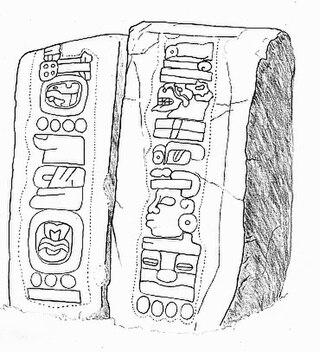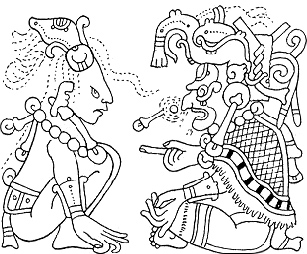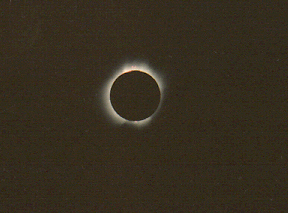The Maya calendar is a system of calendars used in pre-Columbian Mesoamerica and in many modern communities in the Guatemalan highlands, Veracruz, Oaxaca and Chiapas, Mexico.

Kʼinich Janaab Pakal I, also known as Pacal or Pacal the Great, was ajaw of the Maya city-state of Palenque in the Late Classic period of pre-Columbian Mesoamerican chronology. He acceded to the throne in July 615 and ruled until his death. Pakal reigned 68 years—the fifth-longest verified regnal period of any sovereign monarch in history, the longest in world history for more than a millennium, and still the longest of any residing monarch in the history of the Americas. During his reign, Pakal was responsible for the construction or extension of some of Palenque's most notable surviving inscriptions and monumental architecture. Pakal is perhaps best known in popular culture for his depiction on the carved lid of his sarcophagus, which has become the subject of pseudoarchaeological speculations.
The tzolkʼin is the 260-day Mesoamerican calendar used by the Maya civilization of pre-Columbian Mesoamerica.

The calendrical systems devised and used by the pre-Columbian cultures of Mesoamerica, primarily a 260-day year, were used in religious observances and social rituals, such as divination.

Maya codices are folding books written by the pre-Columbian Maya civilization in Maya hieroglyphic script on Mesoamerican bark paper. The folding books are the products of professional scribes working under the patronage of deities such as the Tonsured Maize God and the Howler Monkey Gods. The codices have been named for the cities where they eventually settled. The Dresden codex is generally considered the most important of the few that survive.
The Mayan architecture of the Maya civilization spans across several thousands of years, several eras of political change, and architectural innovation before the Spanish colonization of the Americas. Often, the buildings most dramatic and easily recognizable as creations of the Maya peoples are the step pyramids of the Terminal Preclassic Maya period and beyond. Based in general Mesoamerican architectural traditions, the Maya utilized geometric proportions and intricate carving to build everything from simple houses to ornate temples. This article focuses on the more well-known pre-classic and classic examples of Maya architecture. The temples like the ones at Palenque, Tikal, and Uxmal represent a zenith of Maya art and architecture. Through the observation of numerous elements and stylistic distinctions, remnants of Maya architecture have become an important key to understanding their religious beliefs and culture as a whole.

The traditional Maya or Mayan religion of the extant Maya peoples of Guatemala, Belize, western Honduras, and the Tabasco, Chiapas, Quintana Roo, Campeche and Yucatán states of Mexico is part of the wider frame of Mesoamerican religion. As is the case with many other contemporary Mesoamerican religions, it results from centuries of symbiosis with Roman Catholicism. When its pre-Hispanic antecedents are taken into account, however, traditional Maya religion has already existed for more than two and a half millennia as a recognizably distinct phenomenon. Before the advent of Christianity, it was spread over many indigenous kingdoms, all with their own local traditions. Today, it coexists and interacts with pan-Mayan syncretism, the 're-invention of tradition' by the Pan-Maya movement, and Christianity in its various denominations.

Mesoamerica is a historical region and cultural area that begins in the southern part of North America and extends to the Pacific coast of Central America, thus comprising the lands of central and southern Mexico, all of Belize, Guatemala, El Salvador, and small parts of Honduras, Nicaragua and Costa Rica. As a cultural area, Mesoamerica is defined by a mosaic of cultural traits developed and shared by its indigenous cultures.
Mesoamerica, along with Mesopotamia and China, is one of three known places in the world where writing is thought to have developed independently. Mesoamerican scripts deciphered to date are a combination of logographic and syllabic systems. They are often called hieroglyphs due to the iconic shapes of many of the glyphs, a pattern superficially similar to Egyptian hieroglyphs. Fifteen distinct writing systems have been identified in pre-Columbian Mesoamerica, many from a single inscription. The limits of archaeological dating methods make it difficult to establish which was the earliest and hence the progenitor from which the others developed. The best documented and deciphered Mesoamerican writing system, and the most widely known, is the classic Maya script. Earlier scripts with poorer and varying levels of decipherment include the Olmec hieroglyphs, the Zapotec script, and the Isthmian script, all of which date back to the 1st millennium BC. An extensive Mesoamerican literature has been conserved, partly in indigenous scripts and partly in postconquest transcriptions in the Latin script.
A star war was a decisive conflict between rival polities of the Maya civilization during the first millennium AD. The term comes from a specific type of glyph used in the Maya script, which depicts a star showering the earth with liquid droplets, or a star over a shell. It represents a verb but its phonemic value and specific meaning have not yet been deciphered. The name "star war" was coined by the epigrapher Linda Schele to refer to the glyph, and by extension to the type of conflict that it indicates.

The Mesoamerican Long Count calendar is a non-repeating base-20 and base-18 calendar used by several pre-Columbian Mesoamerican cultures, most notably the Maya. For this reason, it is often known as the MayaLong Count calendar. Using a modified vigesimal tally, the Long Count calendar identifies a day by counting the number of days passed since a mythical creation date that corresponds to August 11, 3114 BCE in the proleptic Gregorian calendar. The Long Count calendar was widely used on monuments.

The traditional Mayas generally assume the Moon to be female, and the Moon's perceived phases are accordingly conceived as the stages of a woman's life. The Maya moon goddess wields great influence in many areas. Being in the image of a woman, she is associated with sexuality and procreation, fertility and growth, not only of human beings, but also of the vegetation and the crops. Since growth can also cause all sorts of ailments, the moon goddess is also a goddess of disease. Everywhere in Mesoamerica, including the Mayan area, she is specifically associated with water, be it wells, rainfall, or the rainy season. In the codices, she has a terrestrial counterpart in goddess I.

The Maya civilization was a Mesoamerican civilization that existed from antiquity to the early modern period. It is known by its ancient temples and glyphs (script). The Maya script is the most sophisticated and highly developed writing system in the pre-Columbian Americas. The civilization is also noted for its art, architecture, mathematics, calendar, and astronomical system.

Until the discovery that Maya stelae depicted kings instead of high priests, the Maya priesthood and their preoccupations had been a main scholarly concern. In the course of the 1960s and over the following decades, however, dynastic research came to dominate interest in the subject. A concept of royal ʼshamanismʼ, chiefly propounded by Linda Schele and Freidel, came to occupy the forefront instead. Yet, Classic Maya civilization, being highly ritualistic, would have been unthinkable without a developed priesthood. Like other Pre-Hispanic Mesoamerican priesthoods, the early Maya priesthood consisted of a hierarchy of professional priests serving as intermediaries between the population and the deities. Their basic skill was the art of reading and writing. The priesthood as a whole was the keeper of knowledge concerning the deities and their cult, including calendrics, astrology, divination, and prophecy. In addition, they were experts in historiography and genealogy. Priests were usually male and could marry. Most of our knowledge concerns Yucatán in the Late Postclassic, with additional data stemming from the contemporaneous Guatemalan Highlands.

A total solar eclipse occurred at the Moon’s descending node of the orbit on Thursday, July 11, 1991. A solar eclipse occurs when the Moon passes between Earth and the Sun, thereby totally or partly obscuring the image of the Sun for a viewer on Earth. A total solar eclipse occurs when the Moon's apparent diameter is larger than the Sun's, blocking all direct sunlight, turning day into darkness. Totality occurs in a narrow path across Earth's surface, with the partial solar eclipse visible over a surrounding region thousands of kilometres wide. Totality began over the Pacific Ocean and Hawaii moving across Mexico, down through Central America and across South America ending over Brazil. It lasted for 6 minutes and 53.08 seconds at the point of maximum eclipse. There will not be a longer total eclipse until June 13, 2132. This was the largest total solar eclipse of Solar Saros series 136, because eclipse magnitude was 1.07997.

The solar eclipse of January 6, 2019 was a partial solar eclipse that was visible in East Asia and the North Pacific.
Halach uinik or halach uinic was the name given to the supreme ruler, overlord or chief, as they were called in the colonial period of a Maya kuchkabal.
Kʼinich Yat Ahk II, also known as Ruler 7, was the last ajaw of Piedras Negras, an ancient Maya settlement in Guatemala. He ruled during the Late Classic Period, from 781 to roughly 808 AD. Possibly a descendant of Itzam Kʼan Ahk II, Kʼinich Yat Ahk II ascended the throne upon the death of his brother, the sixth ajaw of the site, Haʼ Kʼin Xook. While Kʼinich Yat Ahk II presided over the destruction of the rival Maya site Pomona, his reign likely ended with Kʼinich Tatbu Skull IV of Yaxchilan capturing and subjugating Piedras Negras. Itzam Kʼan Ahk II left behind several monuments, including stelae at Piedras Negras, a stone seat known as Throne 1 which records either the death or abdication of Haʼ Kʼin Xook, and Panel 3 which recounts the exploits of Itzam Kʼan Ahk II.
Maya astronomy is the study of the Moon, planets, Milky Way, Sun, and astronomical phenomena by the Precolumbian Maya Civilization of Mesoamerica. The Classic Maya in particular developed some of the most accurate pre-telescope astronomy in the world, aided by their fully developed writing system and their positional numeral system, both of which are fully indigenous to Mesoamerica. The Classic Maya understood many astronomical phenomena: for example, their estimate of the length of the synodic month was more accurate than Ptolemy's, and their calculation of the length of the tropical solar year was more accurate than that of the Spanish when the latter first arrived. Many temples from the Maya architecture have features oriented to celestial events.








